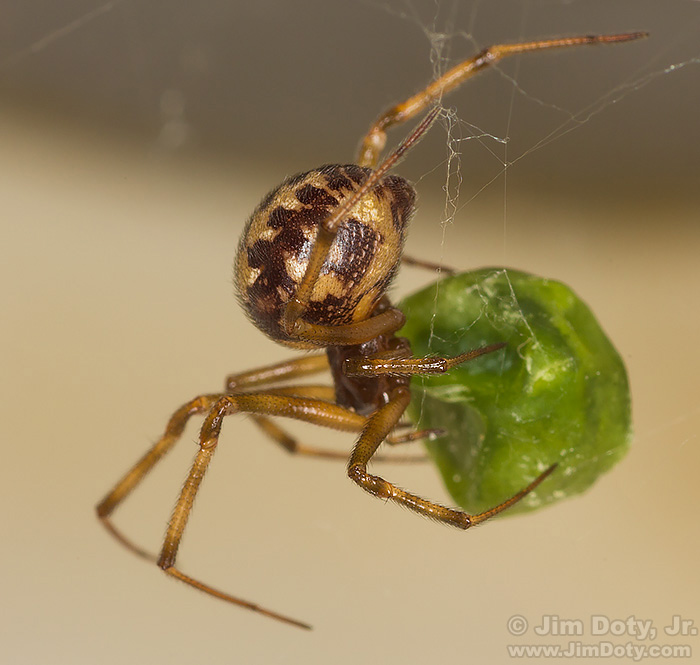I found this common house spider in our kitchen sink, hanging on to this pea which was suspended from an overnight web. The spider wasn’t moving at all so I touched it gently with the tip of a pen to see if it was alive. It quickly ran up a strand of its web. I left it alone and it eventually came back to the object of it’s interest, the pea. It was time to take some pictures.
I put a 100 mm macro lens on my camera to get sufficiently close, along with a macro ring flash to provide light. I set the lens aperture to f/16 since depth of field is very limited in closeup photography. I set the exposure compensation on the flash to about plus one and two thirds (+1 2/3) to compensate for the light color of the sink. Had I not done that, the light from the flash would bounce off the light toned sink and turn the flash off before the dark spider was properly exposed.
The spider was checking out the pea with its pedipalps. Spiders are carnivorous, of course, so I have no idea why this particularly spider was so interested in this pea. Over the next several hours I came back a few times to the sink, and each time the pea was getting smaller. Was the spider sucking the juices out of the pea? That doesn’t make much sense, but who knows? A “test pea” in the kitchen wasn’t shrinking like the spider’s pea. Spiders do drink water. Was this pea a source of moisture? I would have kept watch but we had family visiting so I spent most of my time with them. Our house guests also checked out the spider with its pea.
The next morning the spider was still guarding the pea in the sink which was shriveled to almost nothing. I carefully removed the spider from the sink and took it outside. We are a spider tolerant family, and I have written previously about both of our grown sons having spiders living in their homes. With the exception of the brown recluse, all spiders in our home are left alone or taken outside. A brown recluse is not to be trifled with (ask anyone who has been bitten by one) so any brown recluse inside or outside our home dies an instant death.
Photo data: Canon 5D Mark III. Canon EF100mm f/2.8 Macro lens. 1/125 sec, f/16, ISO 100. Canon Macro Ring Lite MR-14EX.
Links
You can learn about exposure compensation about 3/4 of the way down this page: Using Reflected Light Meters, Part One. Background information is in this article: Speaking Your Camera’s Exposure Language: Aperture, Shutter Speed, and ISO.
Exposure, exposure compensation, flash photography, controlling depth of field, using macro lenses, and closeup photography are all covered in Digital photography Exposure for Dummies. It is one of the highest rated photography books at Amazon.com. Learn more here and order it at Amazon.
My favorite book on closeup photography (by John Shaw).
My favorite book on insect and spider photography (by Larry West). It is out of print so you can click the “Buy at Amazon.com” button to buy it used.

